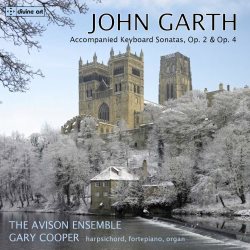| 
|
John GARTH (1712 - 1810)
Accompanied Keyboard Sonatas, Op. 2 and Op. 4
Sonata in G, op. 2,1 [7:47]
Sonata in F, op. 2,2* [7:24]
Sonata in c minor, op. 2,3 [8:04]
Sonata in E flat, op. 2,4** [7:05]
Sonata in A, op. 2,5 [7:58]
Sonata in E, op. 2,6* [9:30]
Sonata in C, op. 4,1 [8:06]
Sonata in e minor, op. 4,2* [6:51]
Sonata in B flat, op. 4,3 [8:17]
Sonata in D, op. 4,4 [6:16]
Sonata in E flat, op. 4,5 [9:44]
Sonata in g minor, op. 4,6** [8:58]
Gary Cooper (harpsichord, fortepiano*, organ**)
The Avison Ensemble (Pavlo Beznosiuk, Caroline Balding (violin), Richard Tunicliffe (cello))
rec. 18-21 April 2008, St Martin's Church, East Woodhay, Hampshire, UK. DDD
DIVINE ART DDA 25115 [48:32 + 48:50]
The Avison Ensemble is a pioneer in the exploration of repertoire
written in north-east England, the region around Newcastle-upon-Tyne
where Charles Avison worked most of his life. The largest part of
his oeuvre has been recorded, and with this disc of music by John
Garth the ensemble turns its attention to a friend and probable pupil
of Avison. He was born in Durham and after finishing his musical education
worked as organist at St Edmund's Church in Sedgefield. He
also became organist to the Bishop of Durham at his official residence,
Auckland Castle. As an organist Garth was highly esteemed: he travelled
far to give recitals and was asked to inaugurate newly-built instruments.
In Durham he set up a concert series. His first attempt in 1742 was
met with little enthusiasm from the cathedral's organist whose
choir was the dominant force in concert life. In 1752 he organised
a subscription series, with the assistance of Avison, in direct competition
to the series of the cathedral choir. The animosity gradually dissipated
and in time the two series integrated. The fact that the cathedral
had a new organist in the person of Thomas Ebdon probably facilitated
this process. Together they promoted the concert series until 1772
when Garth gave up his activities in this field. However, it is possible
that he continued to play at concerts in Durham.
He may have performed some of the sonatas recorded here. The accompanied
keyboard sonata was quite popular at the time, not only in England
but also on the continent, for instance in France. The two series
of six sonatas which are the subject of this set, were printed in
1768 and c.1772 respectively. The fact that the op. 2 set had 261
subscribers for 323 copies shows the reputation of Garth as a composer.
Among the subscribers were famous names such as Charles Burney, James
Nares and John Stanley. The sonatas are all in two movements: an allegro,
followed by a piece in the form of a rondeau or a menuet. This is
music for domestic entertainment, playable by amateurs. The strings
play a subordinate role and only support the keyboard.
Several sonatas include crescendo markings. This "gives an indication
that several of them were conceived for either a pianoforte, or for
one of the new developments in harpsichord-making that made subtle
changes in dynamics possible", according to Simon D.I. Fleming
in the liner-notes. The latter seems more plausible than the former.
Although the new pianoforte was known in England before 1750 it was
only in the 1770s that it started to establish itself as an alternative
to the harpsichord, especially in the London concert scene. That is
not to say that it was also a common instrument elsewhere, and I especially
wonder whether amateurs played such instruments at the time Garth
published his sonatas.
Some of the sonatas here are played at the organ. This could be inspired
by the possibility that Garth - or other organists - may have played
sonatas from these sets in public concerts. There is also a possibility
that some aristocrats owned a small organ. The use of an organ is
probably more plausible than a pianoforte. It is a shame that the
instruments which Gary Cooper plays are not specified in the booklet.
Musical entertainment for amateurs - that could suggest that this
is music which is hardly memorable and goes in one ear and out the
other. My experience is different. It was not hard at all to listen
to these sonatas at a stretch. This is delightful music, very well
written and with plenty of good themes. There is never a dull moment
here, and that is also due to the interpreters. Gary Cooper, Pavlo
Beznosiuk, Caroline Balding and Richard Tunnicliffe deliver energetic
and differentiated performances. This has resulted in a highly entertaining
set of discs, and it is a bit of a mystery to me why these have been
on the shelf for six years.
Johan van Veen
www.musica-dei-donum.org
twitter.com/johanvanveen
 |
 |
|
